#Saint Edith Stein
Explore tagged Tumblr posts
Text
The world is in flames. The conflagration can also reach our house. But high above all flames towers the cross. They cannot consume it. It is the path from earth to heaven. It will lift one who embraces it in faith, love, and hope into the bosom of the Trinity.
Saint Edith Stein
0 notes
Text

Saint Edith Stein
St. Teresa Benedicta of the Cross
1891 - 1942
Feast Day: August 9
Patronage: Europeans, students, professors, philosophers, against the death of parents, for conversion to the fullness of the faith, for courage in living out the faith.
Edith Stein was a German Roman Catholic philosopher and nun. Born into a devout German Jewish family, Edith Stein has baptized a Roman Catholic on January 1, 1922. In 1934 she entered the Carmelite Convent, where she took the name of Teresa Benedicta of the Cross. In 1942 she was caught by the Gestapo, arrested wearing her habit and killed within weeks in the gas chambers at Auschwitz.
Prints, plaques & holy cards available for purchase here: (website)
#Edith Stein#St Teresa Benedicta of the Cross#Saint for Philosophers#Saint for the courage to live the Catholic Faith#catholic women
73 notes
·
View notes
Text
SAINT OF THE DAY (August 9)
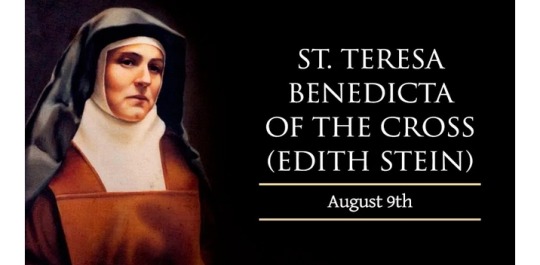
On August 9, the Catholic Church remembers St. Teresa Benedicta of the Cross, also known as St. Edith Stein.
St. Teresa converted from Judaism to Catholicism in the course of her work as a philosopher and later entered the Carmelite Order.
She died in the Nazi concentration camp at Auschwitz in 1942.
Edith Stein was born on 12 October 1891 – a date that coincided with her family's celebration of Yom Kippur, the Jewish “day of atonement.”
Edith's father died when she was just two years old, and she gave up the practice of her Jewish faith as an adolescent.
As a young woman with profound intellectual gifts, Edith gravitated toward the study of philosophy and became a pupil of the renowned professor Edmund Husserl in 1913.
Through her studies, the non-religious Edith met several Christians whose intellectual and spiritual lives she admired.
After earning her degree with the highest honors from Gottingen University in 1915, she served as a nurse in an Austrian field hospital during World War I.
She returned to academic work in 1916, earning her doctorate after writing a highly-regarded thesis on the phenomenon of empathy.
She remained interested in the idea of religious commitment but had not yet made such a commitment herself.
In 1921, while visiting friends, Edith spent an entire night reading the autobiography of the 16th-century Carmelite nun St. Teresa of Avila.
“When I had finished the book,” she later recalled, “I said to myself: This is the truth.”
She was baptized into the Catholic Church on the first day of January 1922.
Edith intended to join the Carmelites immediately after her conversion but would ultimately have to wait another 11 years before taking this step.
Instead, she taught at a Dominican school and gave numerous public lectures on women's issues.
In 1931, she spent her time writing a study of St. Thomas Aquinas and took a university teaching position in 1932.
In 1933, the rise of Nazism, combined with Edith's Jewish ethnicity, put an end to her teaching career.
After a painful parting with her mother, who did not understand her Christian conversion, she entered a Carmelite convent in 1934, taking the name “Teresa Benedicta of the Cross” as a symbol of her acceptance of suffering.
“I felt,” she wrote, “that those who understood the Cross of Christ should take upon themselves on everybody's behalf.”
She saw it as her vocation “to intercede with God for everyone, but she prayed especially for the Jews of Germany whose tragic fate was becoming clear."
“I ask the Lord to accept my life and my death,” she wrote in 1939, “so that the Lord will be accepted by his people and that his kingdom may come in glory, for the salvation of Germany and the peace of the world.”
After completing her final work, a study of St. John of the Cross entitled “The Science of the Cross,” Teresa Benedicta was arrested along with her sister Rosa (who had also become a Catholic) and the members of her religious community on 7 August 1942.
The arrests came in retaliation against a protest letter by the Dutch Bishops, decrying the Nazi treatment of Jews.
Teresa Benedicta of the Cross died in the concentration camp at Auschwitz on 9 August 1942.
Pope John Paul II beatified her as a martyr on 1 May 1987 and then canonized 11 years later on 11 October 1998.
She is one of the six patron saints of Europe, together with Benedict of Nursia, Cyril and Methodius, Bridget of Sweden, and Catherine of Siena.
28 notes
·
View notes
Text


About St Jacinta Marto (left)
About St Edith Stein (Teresa Benedicta of the Cross, right)
Modern Bracket Round 1
#st jacinta marto#st edith stein#st teresa benedicta of the cross#catholic saint tournament#tumblr bracket#polls#tumblr tournament#theology#tumblr polls#christianity#catholic saints#catholicism#catholic
13 notes
·
View notes
Text
Santa Teresia Benedicta a Cruce (Edith Stein)
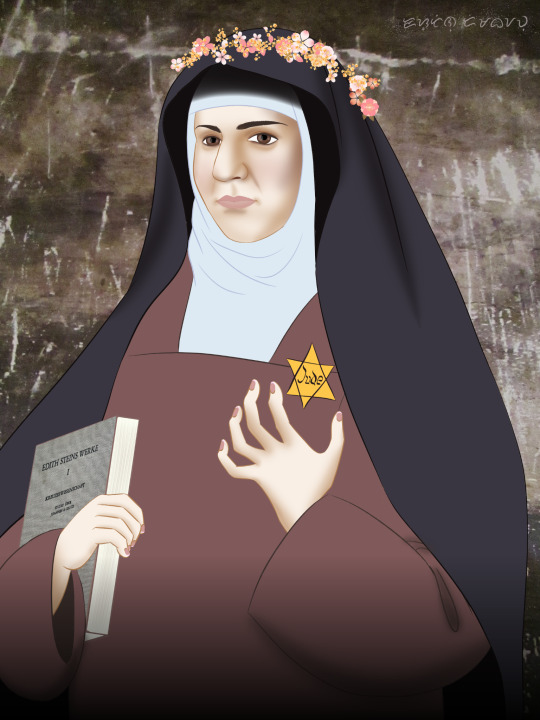
Born and raised Jewish, Edith Stein converted to Catholicism following a period of spiritual dryness. She became a Discalced Carmelite nun, and she adopted the name Teresia Benedicta a Cruce. She was later killed in the gas chambers of Auschwitz for her Jewish heritage.
Iconography: yellow badge; flower crown given to newly cloistered Discalced Carmelite; her book Kreuzeswissenschaft: Studie über Johannes vom Kreuz (The Science of the Cross: A Study of Saint John of the Cross). I also used the image of the scratched gas chamber walls as the background.
#edith stein#Teresa Benedicta of the Cross#jewish convert#catholic convert#religious art#christian art#catholic saints#roman catholic art#catholic art#auschwitz#Holocaust death#carmelites#catholic church#roman catholic#catholique#Holocaust victim#divine feminine#aeshna's art#artstreet medibang#medibangpaint#medibang paint#medibang art#medibang#christian saint#saint#wwii#ww2#world war 2#world war ii#second world war
13 notes
·
View notes
Text

THE DESCRIPTION OF SAINT TERESA BENEDICTA OF THE CROSS (aka Edith Stein) The Carmelite Nun with Jewish Blood and the Patron of World Youth Day and Converted Jews Feast Day: August 9
"The world doesn't need what women have, it needs what women are."
Edith Stein, known as Teresa Benedicta of the Cross, is a martyr of Auschwitz. She was born in Breslau, Lower Silesia, Prussia (now Wrocław, Poland) from a observant and religious Jewish family on October 12, 1891. She was youngest of 11 children, and was born on the holiest day of the Hebrew calendar - Yom Kippur. Edith was a very gifted child who enjoyed learning, in a home where her mother encouraged critical thinking, and she greatly admired her mother's strong religious faith. By her teenage years, however, Stein had become an agnostic, despite her religious background.
Stein arrived at the University of Göttingen in April 1913 in order to study for the summer semester with Edmund Husserl, a German mathematican and philosopher. By the end of the summer, she had decided to pursue her doctoral degree in philosophy under Husserl and chose empathy as her thesis topic. Because of the outbreak of World War I, her studies were interrupted in July 1914. She then served as a volunteer wartime Red Cross nurse in an infectious diseases hospital at Mährisch Weißkirchen in 1915. In 1916, Stein moved to the University of Freiburg in order to complete her dissertation on Empathy. Shortly before receiving her degree from Freiburg she agreed to become Husserl's assistant there. Her dissertation was awarded a doctorate in philosophy with the summa cum laude honor. She then became a member of the faculty at Freiburg, where she worked until 1918 as a teaching assistant to Husserl, who had transferred to that institution.
During this period she also lectures on women's education and vocation and on education in general to very large audiences and to great acclaim. In these lectures, published in ESGA 13 and ESGA 16, she works out for herself the important questions concerning social type and essence, which find a fuller development in The Structure of the Human Person.
She was converted to Christianity in 1921, after reading the autobiography of St. Teresa of Ávila, during summer holidays in Bad Bergzabern, that prompted her conversion and eventually the desire to seek the life of a Discalced Carmelite. Baptized on New Year's Day 1922, and dissuaded by her spiritual advisers from immediately seeking entry to the enclosed and hidden life of a Carmelite nun, Stein obtained a position to teach at the Dominican nuns' school in Speyer from 1923 to 1931. She studied Catholic philosophers and theologians, in particular, Thomas Aquinas, and familiarized herself with Catholic philosophy in general and tried to bridge the phenomenology of her former teacher, Husserl, to Thomism. She visited Husserl and Heidegger at Freiburg in April 1929, the same month that Heidegger gave a speech to Husserl on his 70th birthday. In 1932, she became a lecturer at the Catholic Church-affiliated Institute for Scientific Pedagogy in Münster, but anti-semitic legislation passed by the Nazi government forced her to resign the post in 1933. In a letter to Pope Pius XI, she denounced the Nazi regime and asked the Pope to openly denounce the regime 'to put a stop to this abuse of Christ's name.'
Meanwhile, as the Nazi government imposed antisemitic laws, she wrote a letter in 1933 to Pius XI, asking the Pope to openly denounce Adolf Hitler's regime. Edith entered the Discalced Carmelite monastery St. Maria vom Frieden (Our Lady of Peace) in Cologne-Lindenthal in October 1933, and took the name of Teresa Benedicta of the Cross (Teresia Benedicta a Cruce). In order to avoid the growing Nazi threat, the Order transferred Edith and her sister, Rosa, who was also a convert and an extern sister of the Carmel, to the Discalced Carmelite monastery in Echt, Netherlands. There she wrote Studie über Joannes a Cruce: Kreuzeswissenschaft ('Studies on John of the Cross: The Science of the Cross').
Ultimately, she would not be safe in the Netherlands. The Dutch Bishops' Conference had a public statement read in all churches across the nation on July 20, 1942 condemning Nazi racism. In a retaliatory response on July 26, 1942, the Reichskommissar of the Netherlands, Arthur Seyss-Inquart, ordered the arrest of all Jewish converts who had previously been spared. Along with two hundred and forty-three baptized Jews living in the Netherlands, Edith and her sister were arrested by the SS (Schutzstaffel) in the monastery on August 2, 1942. She and her sister Rosa were imprisoned at the concentration camps of Amersfoort and Westerbork before being deported to Auschwitz. A Dutch official at Westerbork was so impressed by her sense of faith and calm, he offered her an escape plan. Stein vehemently refused his assistance, stating: 'If somebody intervened at this point and took away [her] chance to share in the fate of [her] brothers and sisters, that would be utter annihilation.'
Early in the morning on August 7, 1942, 987 Jews were deported to the Auschwitz concentration camp. It was probably on August 9th that Edith, her sister Rosa, and many more Jews were killed in a gas chamber. Edith was 50 years old when she received the crown of martyrdom.
Beatified on May 1, 1987 in Cologne, Germany and canonized eleven years later on October 11, 1998 by St. John Paul II in the Vatican, Edith Stein is one of the six patron saints of Europe, together with Benedict of Nursia, Cyril and Methodius, Bridget of Sweden, and Catherine of Siena. Her feast day was officially added to the Episcopal Church liturgical calendar with a feast day to this day in 2022.
#random stuff#catholic#catholic saints#carmelites#edith stein#teresa benedicta of the cross#teresia benedicta a cruce
2 notes
·
View notes
Photo


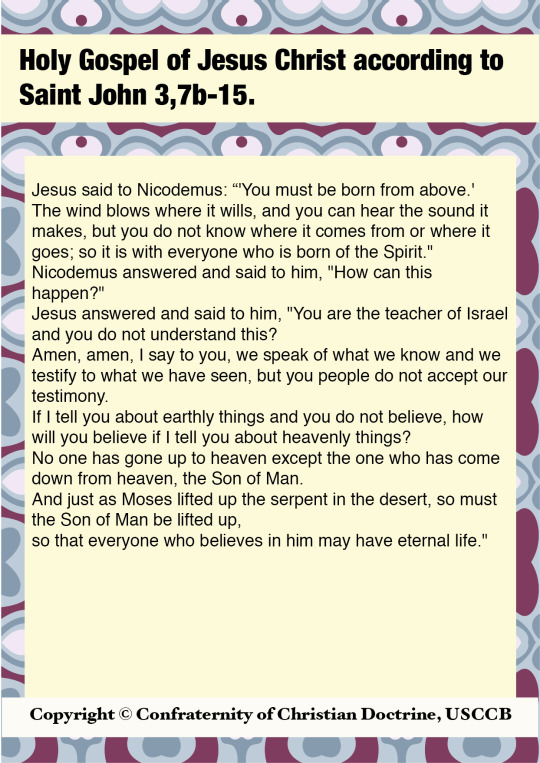
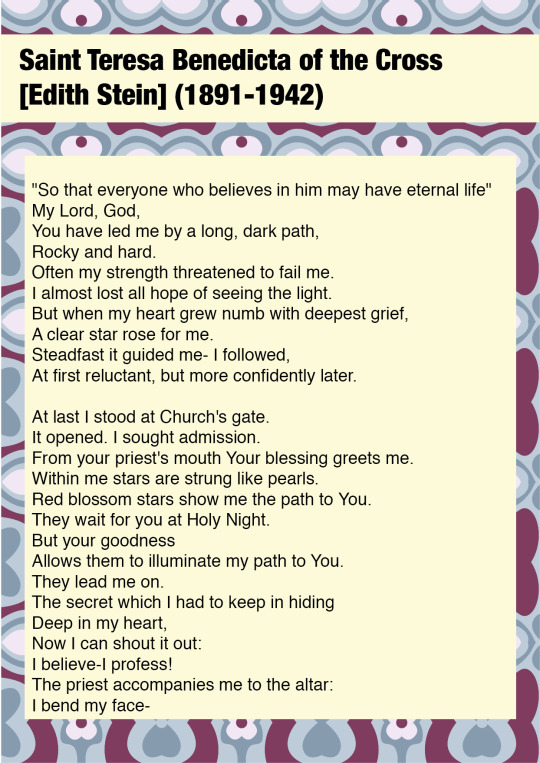
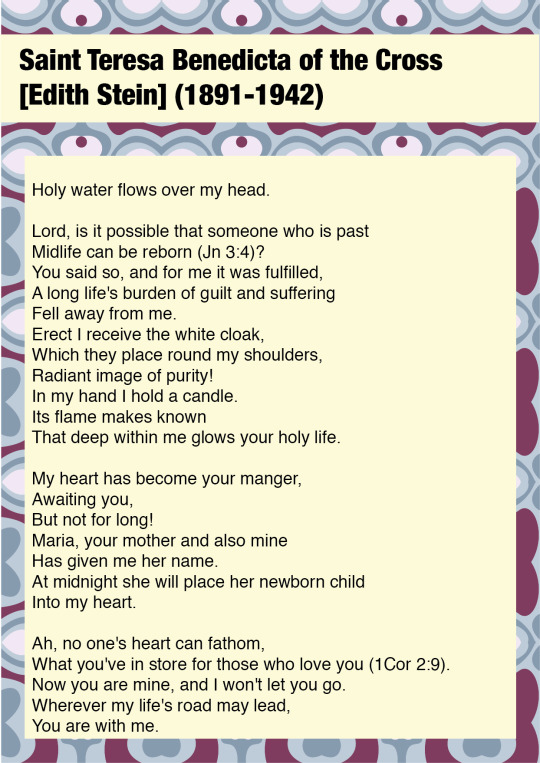
Readings for 18 APRIL
18/4/2023
#Acts of the Apostles 4#Acts of the Apostles#Psalms 93(92)#Psalms#Holy Gospel of Jesus Christ according to Saint John 3#Holy Gospel of Jesus Christ according to Saint John#Saint Teresa Benedicta of the Cross [Edith Stein] (1891-1942)#So that everyone who believes in him may have eternal life#God#Lord#Jesus#Holy Spirit#love#hope#heaven
1 note
·
View note
Text
2023 APRIL 18 Tuesday
"Ah, no one's heart can fathom, What you've in store for those who love you."
~ Saint Teresa Benedicta of the Cross [Edith Stein], paraphrasing 1 Corinthians 2:9 in Poem: "Heilige Nacht"
#bible#gospel#further reading#saint#Teresa Benedicta of the Cross#Edith Stein#Heilige Nacht#Corinthians#no one#heart#fathom#God#Lord#Jesus#Christ#plans#in store#love
0 notes
Text
writing a paper on second wave feminism and the catholic church and going into it i was not prepared for the level at which people think the church is oppressing and suppressing women.
like girl where
is it. is it one of the countless churches named after. the mother of God. or. or the hundreds of female saints. or. the art on the walls. or the nuns who are the life of a parish. or. what. are we looking at the same thing here. it's our seventh Marian feast day of the year. later we have a whole day in honor of Edith Stein. sometimes men take the names of women. by choice. in their teen years. is that. is that where women are getting oppressed by the church
#like don't get me wrong PEOPLE and INDIVIDUALS be out here oppressing the HELL out of women#but THE CHURCH??? THE STRUCTURE!??!?!?!#bitch to be so respectful with you <3 no <3#the church is not oppressing women#it is THAT priest#it is THAT husband#it is THAT man#it is THOSE women#the church as a whole herself is not oppressing anyone#catch me in my feminist moment#there are many benefits to attending a catholic college#catholic things
388 notes
·
View notes
Text
“Masculinity and femininity, although expressed in various ways through history and cultures, are ordered toward an end: spousal union and parenthood.(33) However, the truth of sexual difference does not require men and women to fit into narrow cultural expectations of gender. In fact, there are many ways for individuals to express the natural reality of our sexed identities as male and female. Take, for example, Sister Deirdre Byrne, who is a missionary religious sister, a board-certified family practitioner and surgeon, and a colonel in the United States Army. She is well aware that there is more than one way for a woman to express her femininity. She did not do these things instead of motherhood. Rather, she mothered through these things. In the words of Saint Edith Stein, "Thus the participation of women in the most diverse professional disciplines could be a blessing for the entire society, private or public, precisely if the specifically feminine ethos would be preserved."(34)
-Jason Evert, Male, Female, or Other: A Catholic Guide to Understanding Gender
—
Work cited:
33) Cf. John Paul II, TOB 14:5
34) Edith Stein, "The Ethos of Women's Professions," in Essays on Women, (Washington D.C.: ICS Publications, 1996), 50.
— For more recommended resources on gender dysphoria, click here.
#Feminism#lgbtq+#nonbinary#genderfluid#transgenderism#transgender ideology#jason evert#quotes#Male Female Other: A Catholic Guide to Understanding Gender
15 notes
·
View notes
Text

"Saint Teresa Benedicta of the Cross (Edith Stein), Pray for Us!" #SaintoftheDay #OraProNobis
📷 Passport Photo of Edith Stein / Cologne Carmel Archives / #Wikipedia (PD-Art). #Catholic_Priest #CatholicPriestMedia
10 notes
·
View notes
Text

Saint Edith Stein
St Teresa Benedicta of the Cross
1891 - 1942
Feast Day: August 9
Patronage: Europeans, students, professors, philosophers, against death of parents, for conversion to the fullness of the faith, for courage in living out the faith.
Edith Stein was a German Roman Catholic philosopher and nun. Born into a devout German Jewish family, Edith Stein was baptized a Roman Catholic on January 1, 1922. In 1934 she entered the Carmelite Convent, where she took the name of Teresa Benedicta of the Cross. In 1942 she was caught by the Gestapo, arrested wearing her habit and killed within weeks in the gas chambers at Auschwitz.
Prints, plaques & holy cards available for purchase here: (website)
#St Edith Stein#St Teresa Benedicta of the Cross#Saint for students#Saint for professors#artist on tumblr
120 notes
·
View notes
Text
SAINT OF THE DAY (August 9)

On August 9, the Catholic Church remembers St. Teresa Benedicta of the Cross, also known as St. Edith Stein.
St. Teresa converted from Judaism to Catholicism in the course of her work as a philosopher and later entered the Carmelite Order.
She died in the Nazi concentration camp at Auschwitz in 1942.
Edith Stein was born on 12 October 1891 — a date that coincided with her family's celebration of Yom Kippur, the Jewish “day of atonement.”
Edith's father died when she was just two years old, and she gave up the practice of her Jewish faith as an adolescent.
As a young woman with profound intellectual gifts, Edith gravitated toward the study of philosophy and became a pupil of the renowned professor Edmund Husserl in 1913.
Through her studies, the non-religious Edith met several Christians whose intellectual and spiritual lives she admired.
After earning her degree with the highest honors from Gottingen University in 1915, she served as a nurse in an Austrian field hospital during World War I.
She returned to academic work in 1916, earning her doctorate after writing a highly-regarded thesis on the phenomenon of empathy.
She remained interested in the idea of religious commitment but had not yet made such a commitment herself.
In 1921, while visiting friends, Edith spent an entire night reading the autobiography of the 16th-century Carmelite nun, St. Teresa of Avila.
“When I had finished the book,” she later recalled, “I said to myself: This is the truth.”
She was baptized into the Catholic Church on the first day of January 1922.
Edith intended to join the Carmelites immediately after her conversion but would ultimately have to wait another 11 years before taking this step.
Instead, she taught at a Dominican school and gave numerous public lectures on women's issues.
She spent 1931 writing a study of St. Thomas Aquinas and took a university teaching position in 1932.
In 1933, the rise of Nazism, combined with Edith's Jewish ethnicity, put an end to her teaching career.
After a painful parting with her mother, who did not understand her Christian conversion, she entered a Carmelite convent in 1934, taking the name “Teresa Benedicta of the Cross” as a symbol of her acceptance of suffering.
“I felt,” she wrote, “that those who understood the Cross of Christ should take upon themselves on everybody's behalf.”
She saw it as her vocation “to intercede with God for everyone,” but she prayed especially for the Jews of Germany whose tragic fate was becoming clear.
“I ask the Lord to accept my life and my death,” she wrote in 1939, “so that the Lord will be accepted by his people and that his kingdom may come in glory, for the salvation of Germany and the peace of the world.”
After completing her final work, a study of St. John of the Cross entitled “The Science of the Cross,” Teresa Benedicta was arrested, along with her sister Rosa (who had also become a Catholic) and the members of her religious community, on 7 August 1942.
The arrests came in retaliation against a protest letter by the Dutch Bishops, decrying the Nazi treatment of Jews.
Teresa Benedicta of the Cross died in the concentration camp at Auschwitz on 9 August 1942.
Pope John Paul II beatified her on 1 May 1987 and canonized on 11 October 1998.
She is one of the six patron saints of Europe, together with Benedict of Nursia, Cyril and Methodius, Bridget of Sweden, and Catherine of Siena.
1 note
·
View note
Note
Another vote for Edith Stein aka Teresa Benedicta of the Cross! And also a vote for Dorothy Parker
YAY VOTES!!!
Another vote added for Edith Stein AKA St Teresa Benedicta
And I think you mean Dorothy Day? Dorothy Parker was a very cool poet and all but Dorothy Day is our special girl here at this blog!
14 notes
·
View notes
Text

Saint Teresa Benedicta of the Cross - (Edith Stein) Feast Day: August 9
6 notes
·
View notes
Note
Please give me reading recommendations (esp the Jewish-catholic theologian-philosopher-mystics!)
gillian rose, love's work
edith stein's essential writings
etty hillesum, an interrupted life: the diaries and letters
simone weil, gravity and grace
chris kraus, aliens & anorexia (fiction)
hannah arendt, love and saint augustine (her doctoral thesis... she has far more influential works but i loved this one)
teresa of avila's autobiography
if you like poetry: louise glück, paul celan, denise levertov
48 notes
·
View notes